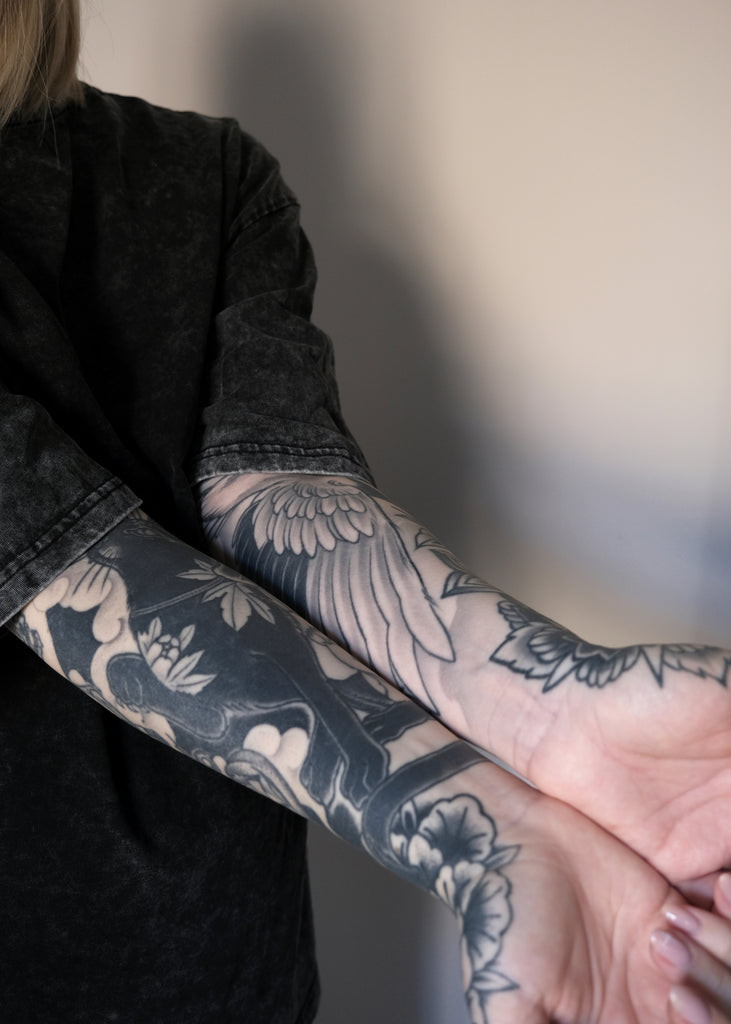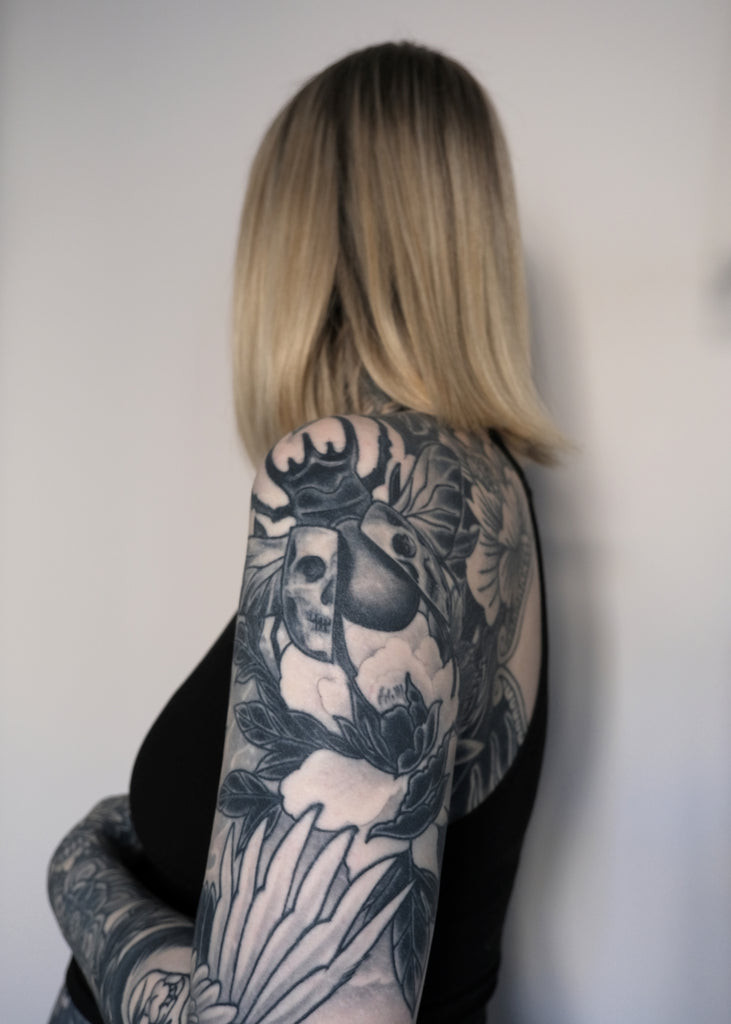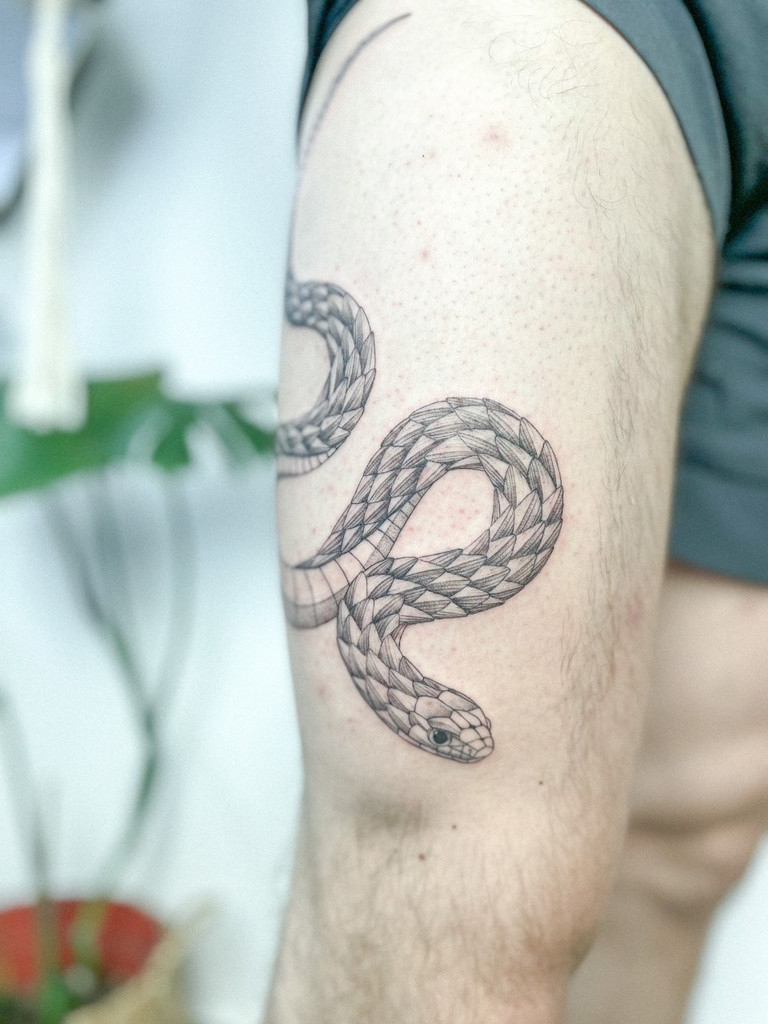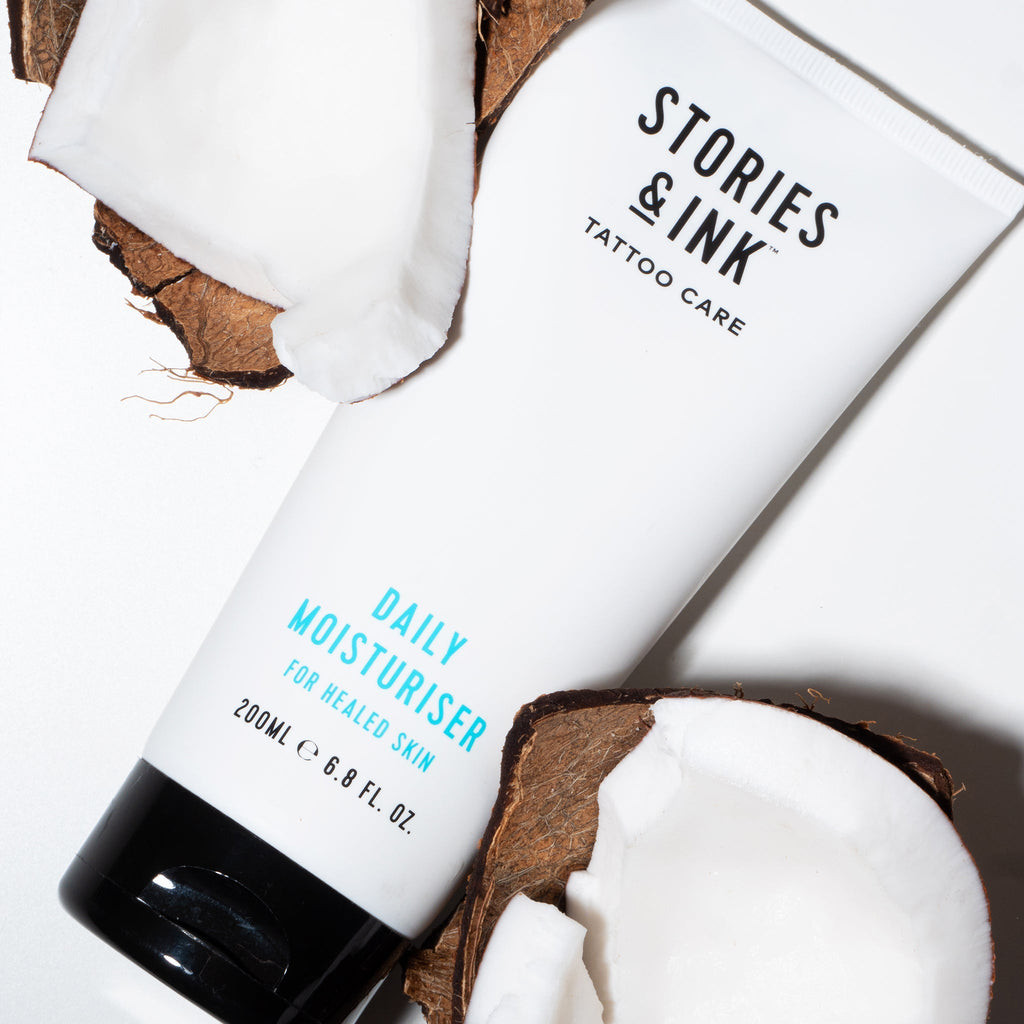Do Small Tattoos Hurt? Small tattoos can be relatively less painful compared to larger ones because they involve less time and less extensive work on the skin, but pain perception varies. At tattooat.com, we believe in providing you with all the information you need to make informed decisions about your body art journey, from understanding pain levels to finding the perfect design. Discover the art of tattooing with confidence, exploring minimalist tattoos, fine line art, and delicate designs, ensuring your experience is both beautiful and manageable.
1. What Factors Influence Tattoo Pain Levels?
Tattoo pain is subjective, but several factors influence how much discomfort you might experience; understanding these can help you prepare for your tattoo session.
The following factors can have an impact:
| Factor | Description |
|---|---|
| Tattoo Placement | Areas with more nerve endings, thinner skin, or close proximity to bone tend to be more sensitive. |
| Tattoo Size | Larger tattoos typically involve longer sessions, leading to increased discomfort over time. |
| Pain Tolerance | Individual pain thresholds vary widely; what one person finds manageable, another may find intense. |
| Tattoo Technique | Different tattooing styles and the skill of the artist can affect the level of pain experienced. |
| Mental State | Stress, anxiety, and fatigue can lower pain tolerance, making the experience more painful. |
| Physical Condition | Hydration, nutrition, and adequate sleep can positively influence your body’s ability to handle pain. |
Understanding these factors allows you to better prepare for your tattoo session and manage your expectations. At tattooat.com, we offer resources and guidance to help you navigate these variables for a more comfortable experience.
2. Where Are the Least Painful Spots for a Small Tattoo?
Choosing the right location can significantly reduce discomfort; generally, areas with more fat, fewer nerve endings, and thicker skin are less painful.
Consider these options for a less painful experience:
- Outer Thigh: This area typically has more fat and fewer nerve endings.
- Outer Arm: The skin on the outer arm is thicker and less sensitive.
- Calves: The fleshy area of the calves can be a good option.
- Forearm: One of the most popular and least painful spots for a tattoo.
 Forearm tattoos
Forearm tattoos
Forearms are a popular choice for tattoos, known for being one of the less painful areas. Image depicts forearm tattoos on @barbaradzerve.
According to a survey conducted by Inked Magazine in 2023, the forearm is consistently ranked as one of the least painful places to get a tattoo due to its thick skin and fewer nerve endings.
3. Where Are the Most Painful Spots for a Small Tattoo?
Conversely, some areas are known for being more sensitive; these spots typically have thin skin, many nerve endings, or are close to bone.
Avoid these areas if you’re concerned about pain:
- Ribs: Very little fat and close proximity to bone make this a sensitive area.
- Spine: The spine is very bony and has many nerve endings.
- Feet and Ankles: Thin skin and numerous nerve endings contribute to increased pain.
- Head and Face: Many nerve endings make these areas highly sensitive.
- Armpits: High concentration of nerve endings and sensitive skin.
Understanding these locations can help you make a more informed decision about your tattoo placement. At tattooat.com, we provide detailed guides and resources to help you choose the best spot for your tattoo.
4. How Does Age Affect Tattoo Pain?
Age can play a role in how you perceive pain, though experiences vary.
Here’s how age might affect your pain perception:
| Age Group | Potential Effects |
|---|---|
| Younger | May experience pain more intensely due to higher nerve sensitivity; however, they may also have a higher tolerance due to resilience. |
| Older | Pain sensitivity may decrease with age, but the ability to endure longer sessions might also diminish. |
According to research from Portland State University’s Art Department, in July 2025, age-related changes in nerve sensitivity can affect pain perception during tattooing.
5. Does Biological Sex Influence Tattoo Pain?
Research suggests that biological sex can influence pain perception, but individual experiences vary greatly.
Key points to consider:
- Hormonal Differences: Fluctuations in hormone levels can affect pain sensitivity.
- Pain Threshold: Some studies suggest biological women may experience greater pain intensity.
- Individual Variation: Personal pain tolerance is the most significant factor.
According to a study published in the Journal of Pain Research, hormonal variations can influence pain perception, with some individuals experiencing heightened sensitivity during certain times of the month.
6. Can Tattoo Technique Affect Pain Levels?
The technique used by the tattoo artist can significantly impact your experience; skilled artists can minimize discomfort.
Different techniques and their effects:
| Technique | Description | Pain Level Impact |
|---|---|---|
| Fine Line | Involves delicate, thin lines; generally less painful due to less trauma to the skin. | Lower |
| Bold Line | Uses thicker, more prominent lines; can be more painful due to more extensive work. | Higher |
| Shading | Creates depth and dimension through varying shades of ink; pain levels can vary depending on the area. | Moderate |
| Hand-Poked | A manual technique using a single needle; some find it less painful, others more so. | Varies; some find it gentler, others more intense. |
Choosing an experienced artist who is skilled in the technique you prefer can make a significant difference in your comfort level. At tattooat.com, we can help you find talented artists in your area.
7. How Does the Duration of a Tattoo Session Affect Pain?
The length of your tattoo session is a crucial factor in how much pain you experience; longer sessions can lead to increased discomfort and fatigue.
Key factors to consider:
- Adrenaline: Initially, adrenaline can help mask the pain, but its effects diminish over time.
- Skin Sensitivity: The longer the session, the more sensitive your skin becomes.
- Mental Fatigue: Mental exhaustion can lower your pain tolerance.
- Breaks: Taking regular breaks can help manage pain and discomfort.
Breaking up larger designs into multiple sessions can make the process more manageable.
8. How Do Emotional and Physical States Impact Tattoo Pain?
Your emotional and physical well-being on the day of your appointment can significantly influence your pain experience.
Factors to consider:
- Stress and Anxiety: High stress levels can increase pain sensitivity.
- Sleep Deprivation: Lack of sleep can lower your pain tolerance.
- Hydration and Nutrition: Being well-hydrated and having eaten a meal can help stabilize your pain threshold.
- Relaxation Techniques: Practicing relaxation techniques can help manage pain and anxiety.
Ensure you are well-rested, hydrated, and relaxed before your tattoo session.
9. Can Tattoos Over Scars or Stretch Marks Hurt More?
Tattooing over scars or stretch marks can be more painful due to the altered structure of the skin; however, experiences vary.
Key considerations:
- Scar Tissue: Scar tissue can be more sensitive and less elastic than normal skin.
- Stretch Marks: Skin with stretch marks may be more sensitive due to the damage to collagen and elastin fibers.
- Artist Experience: An experienced artist can adjust their technique to minimize discomfort.
Consulting with your tattoo artist about the specific characteristics of your scars or stretch marks is essential.
10. Do Cover-Up Tattoos Hurt More Than New Tattoos?
Cover-up tattoos, which go over existing tattoos, can sometimes be more painful due to multiple layers of ink and potential scar tissue.
Factors to consider:
- Ink Density: Tattooing over existing ink requires more work and can be more painful.
- Scarring: Previous tattooing may have caused scarring, increasing sensitivity.
- Session Length: Cover-ups often require longer sessions, leading to increased discomfort.
Discussing the potential for increased pain with your artist can help you prepare for the session.
 Upper arm tattoos
Upper arm tattoos
The outer upper arm is another area generally considered less painful for tattoos. Image features upper arm tattoos.
Writer and tattoo collector Alice Snape (@alicecsnape) shared her experience:
“I didn’t hate [getting] my bum [tattooed]. I’d heard it was the most painful place ever, so maybe I was just pleasantly surprised it didn’t live up to those expectations.”
11. What Aftercare Practices Can Minimize Pain and Promote Healing?
Proper aftercare is crucial for minimizing pain and ensuring your tattoo heals well.
Essential aftercare steps:
- Keep it Clean: Gently wash the tattooed area with mild soap and water.
- Moisturize: Apply a thin layer of tattoo-specific moisturizer to keep the skin hydrated.
- Avoid Sun Exposure: Protect your tattoo from the sun to prevent fading and damage.
- Don’t Pick or Scratch: Avoid picking or scratching the tattoo to prevent infection and scarring.
- Stay Hydrated: Drinking plenty of water helps your skin heal.
Following these aftercare practices can significantly reduce discomfort and promote optimal healing. We can also recommend having a look at our tattoo aftercare products
12. Can Numbing Creams Help Reduce Tattoo Pain?
Numbing creams can be effective in reducing pain during tattoo sessions, but it’s essential to use them safely and correctly.
Key considerations:
- Types of Creams: Over-the-counter and prescription numbing creams are available.
- Active Ingredients: Look for creams containing lidocaine, tetracaine, or prilocaine.
- Application: Apply the cream as directed by your tattoo artist, usually 1-2 hours before the session.
- Potential Side Effects: Be aware of potential side effects, such as allergic reactions or skin irritation.
Consult with your tattoo artist before using numbing creams to ensure they are appropriate for your skin and the tattoo process.
13. How Can I Mentally Prepare for a Tattoo Session?
Mental preparation can significantly impact your experience; managing anxiety and setting realistic expectations can help.
Strategies for mental preparation:
- Research: Understand the tattoo process and what to expect.
- Relaxation Techniques: Practice deep breathing, meditation, or visualization.
- Positive Mindset: Focus on the artistic and personal value of the tattoo.
- Distraction: Bring music, a book, or a friend to help distract you during the session.
Approaching your tattoo session with a calm and positive attitude can make a significant difference.
14. What Are Some Popular Small Tattoo Ideas?
Small tattoos offer a way to express yourself with minimalist designs that are often less painful and quicker to complete.
Popular ideas include:
- Symbols: Small symbols like hearts, stars, or infinity signs.
- Animals: Minimalist outlines of animals or insects.
- Flowers: Delicate floral designs.
- Words/Quotes: Short meaningful words or phrases.
- Geometric Shapes: Simple geometric patterns.
At tattooat.com, you can discover a vast array of design ideas to inspire your next tattoo.
15. How to Choose the Right Tattoo Artist for a Small Tattoo?
Choosing the right artist is crucial for ensuring a positive experience and a beautiful result.
Key steps to consider:
- Portfolio Review: Look at the artist’s portfolio to assess their style and skill.
- Read Reviews: Check online reviews and testimonials from previous clients.
- Consultation: Schedule a consultation to discuss your design and ask questions.
- Studio Hygiene: Ensure the studio is clean and follows strict hygiene practices.
- Communication: Choose an artist who listens to your ideas and communicates effectively.
Taking the time to find the right artist can ensure a tattoo you’ll love for years to come.
 Thigh tattoo
Thigh tattoo
The outer thigh is often chosen as a less painful area for tattoos. This image displays a snake tattoo design by @mastattoos.
16. Understanding the Tattoo Process: What to Expect
Knowing what to expect during the tattoo process can help ease anxiety and prepare you for the experience.
The typical tattoo process involves:
- Consultation: Discussing your design and placement with the artist.
- Preparation: Shaving and cleaning the area to be tattooed.
- Stencil Application: Transferring the design onto your skin using a stencil.
- Tattooing: The artist uses a tattoo machine to apply ink to your skin.
- Aftercare Instructions: Receiving instructions on how to care for your new tattoo.
Being informed about each step can help you feel more comfortable and confident.
17. How Does Skin Hydration Affect Tattoo Pain and Healing?
Proper skin hydration plays a crucial role in both pain management and the healing process of a tattoo.
Benefits of hydrated skin:
- Increased Elasticity: Well-hydrated skin is more elastic, which can reduce discomfort during tattooing.
- Improved Ink Absorption: Hydrated skin absorbs ink more effectively, leading to better results.
- Faster Healing: Hydrated skin heals faster and more efficiently.
- Reduced Sensitivity: Hydrated skin is less sensitive to pain.
Drink plenty of water in the days leading up to your tattoo appointment and continue to hydrate during the healing process.
18. What Are Some Common Misconceptions About Tattoo Pain?
Several misconceptions about tattoo pain can create unnecessary anxiety; understanding the truth can help you feel more at ease.
Common misconceptions:
- “All tattoos are extremely painful”: Pain levels vary depending on placement and individual tolerance.
- “Men have a higher pain tolerance”: Pain tolerance is individual and not solely determined by sex.
- “Numbing creams eliminate pain completely”: Numbing creams can reduce pain, but they don’t eliminate it entirely.
- “The first tattoo is always the worst”: Experiences vary, and many people find subsequent tattoos less daunting.
Debunking these myths can help you approach your tattoo session with a more realistic and positive mindset.
19. Exploring Cultural Perspectives on Tattoo Pain
Different cultures have varying perspectives on tattoo pain, often viewing it as a rite of passage or a symbol of strength.
Cultural examples:
- Polynesian Cultures: Traditional tattooing involves significant pain, seen as a test of endurance and commitment.
- Japanese Cultures: Irezumi, traditional Japanese tattoos, are often large and involve lengthy, painful sessions.
- Indigenous Cultures: Many indigenous cultures view tattoo pain as a spiritual experience, connecting individuals to their ancestors and traditions.
Understanding these cultural perspectives can provide a deeper appreciation for the art of tattooing.
20. How to Prepare Your Skin Before Getting a Small Tattoo
Preparing your skin properly before getting a tattoo can help minimize pain, improve ink absorption, and promote faster healing.
Steps for skin preparation:
- Exfoliate: Gently exfoliate the area to remove dead skin cells.
- Moisturize: Keep the skin well-moisturized in the days leading up to your appointment.
- Avoid Sunburn: Protect the area from sunburn, as damaged skin is more sensitive.
- Stay Hydrated: Drink plenty of water to hydrate your skin from the inside out.
- Avoid Irritants: Avoid using harsh chemicals or irritants on the skin before your appointment.
Properly preparing your skin can contribute to a more comfortable and successful tattoo experience. Before you’ve been tattooed we recommend our Daily Moisturiser. It’ll help prepare your skin for a new tattoo with hydrating and nourishing ingredients. Just don’t use it on the day of your appointment as it can stop the stencil from sticking. For more info, read our preparation guide to find out how you can prepare for a new tattoo, and hopefully have the least painful experience possible.
 Stories & Ink Daily Moisturiser
Stories & Ink Daily Moisturiser
Stories & Ink’s Daily Moisturiser helps prepare your skin for a new tattoo.
FAQ About Small Tattoo Pain
1. Is getting a small tattoo on the wrist painful?
Yes, wrist tattoos can be moderately painful due to thin skin and nerve endings.
2. Do finger tattoos hurt more than arm tattoos?
Yes, finger tattoos are generally more painful than arm tattoos due to the lack of muscle and fat.
3. Can I take pain relievers before getting a tattoo?
Consult your artist before taking any pain relievers, as some can thin the blood.
4. How long does the pain of a small tattoo last?
The initial pain lasts during the session, with residual soreness for a few days.
5. Does the placement affect the healing time?
Yes, areas with more movement or friction may take longer to heal.
6. Are some ink colors more painful to apply?
No, the color of the ink does not affect the level of pain.
7. How can I distract myself during a tattoo session?
Listen to music, watch videos, or talk to your artist.
8. Is it better to get a tattoo when you’re relaxed?
Yes, being relaxed can help lower your pain perception.
9. Can I use ice packs to reduce pain after getting a tattoo?
Yes, ice packs can help reduce swelling and pain after getting a tattoo.
10. How do I know if my tattoo is infected?
Signs of infection include excessive redness, swelling, pus, and fever.
Ready to explore the world of tattoos with confidence? At tattooat.com, discover a wealth of inspiration, connect with talented artists, and gain the knowledge you need for a smooth and enjoyable tattoo journey. Explore our diverse collection of designs, find an artist whose style resonates with you, and dive into our comprehensive guides. Don’t wait—start your adventure today and bring your vision to life.
